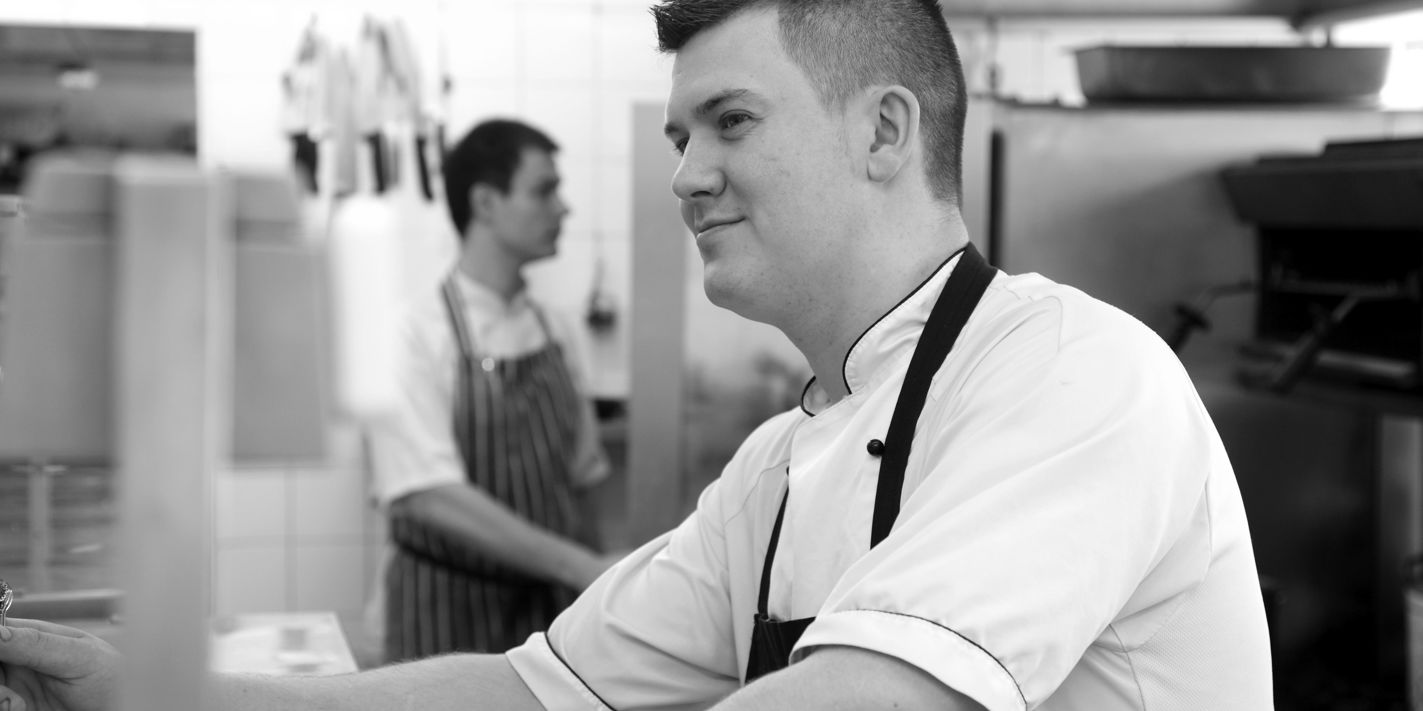Graham Campbell

Graham Campbell
Graham Campbell has achieved extraordinary success in his career so far, becoming the youngest person in Scotland to receive a Michelin star at the age of twenty-five. Using traditional Scottish and British ingredients as a base, he uses innovative and creative flavour combinations to create something truly unique.
Graham Campbell wanted to be a chef from an early age. His first job as ‘the lowest of the low’ was at the Caledonian Hotel in his hometown of Oban, where he progressed to sous chef before moving down to Rochdale for a position at Andrew Nutter’s eponymous restaurant. ‘There was finely presented food – loads of produce and dishes that I had just never seen before,' says Graham. 'I had to make a lemon tart and I didn’t have a clue how to do it.’
Moving on to Paul Heathcote’s Longridge, he worked under head chef James Holah, previously sous chef at Claridge’s, and it was here that his fine dining career began in earnest. ‘That was a real eye opener,' he says. 'I got introduced to many new foods; I had never seen foie gras or mushroom ravioli, I had no idea that any of that existed. They put me on larder and asked me to make an amuse bouche – I had no idea what that was.’ Within three months he was sous chef.
In 2008 he decided to move back to Scotland, taking up a position as head chef at The Ballachulish House near Fort William. Cooking a small menu for the restaurant’s select clientele, he took everything he had learnt from Heathcote’s and made it his own. In 2009 he was awarded a Michelin star for his food, much to his surprise, becoming the youngest chef in Scotland to receive a Michelin star at just twenty-five. The restaurant closed shortly after, but this unexpected affirmation of his talents proved a huge motivator. ‘That is when I started buying all the books and researching myself, and since then it has always been about me and what I do,' says Graham. 'I dabble and experiment with flavours.’
Stints running the kitchens at the Lake of Menteith Hotel in Perthshire and The Monastery in Manchester followed, where he cooked bold, flavour-rich dishes such as Chilled pea velouté with fennel sorbet and poached apricots, Confit belly of pork stuffed with black pudding with braised red cabbage, mash and cider jus, and Kumquat panettone with orange blossom panna cotta and confit kumquats. One of his favourite ingredients is Goosnargh duck, a preference picked up while working at Longridge, where Paul Heathcote championed the production of this specially bred animal at a dedicated Lancashire farm back in the 1990s. This flavour-packed, low-fat duck, which Graham describes as ‘amazing’, made a regular appearance in his menus, such as this Honey-marinated Goosnargh duck breast with sautéed greens and crispy noodles.
Graham then took up a role as executive chef at the Mither Tap Restaurant at Pittodrie House Hotel, where utilising the local bounty he produced beautiful, seasonal plates such as scallops with ceviche, radish and fruit, Wild sea bream with gnocchi, pea, asparagus and saffron and Pan-roasted cod with confit new potatoes, pancetta, samphire and lemon.
In 2015, Graham was offered the head chef position at the award-winning Dundee restaurant, Castlehill. There he continued to focus on local produce, while incorporating the latest international ingredients into his dishes. Signature dishes included ballotine of foie gras, wild halibut and scallop tortellini in a vanilla velouté with black olive crushed potatoes and broccoli and raspberry soufflé with lemon balm sorbet and crème anglaise.
Foraged edibles also played a greater part in Graham's menus, inspired by the remarkable variety that can be found in Dundee’s thick woodlands. ‘We use wild garlic, all the sorrels, ground elder, pink purslane and sweet cicely,' he explains. 'We go foraging a lot for mushrooms when they are in season. We have plants in the garden – people call them weeds – but I actually put them on the plate because they go with all the flavours I’ve got. I use wild flowers and things like that. Plants that were obviously used back in the day, but have just been forgotten about, gone wild and classed as a weed now.’
Graham's style of cooking is still very much evolving. He says he uses traditional ingredients and flavours as his base, then enhances and contrasts from there, producing innovative and flavoursome combinations. ‘I take traditional ingredients and create the unexpected,' he says. 'I like to keep it a bit unusual, to show people something different.' With the restaurant firmly established as one of the best in Scotland, Graham left Castlehill in January 2019.


